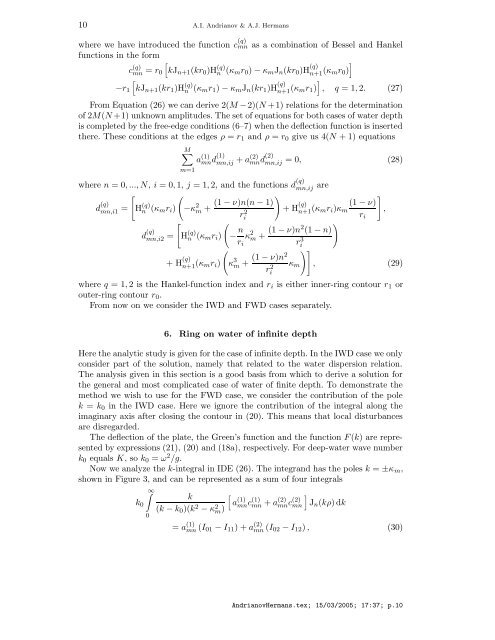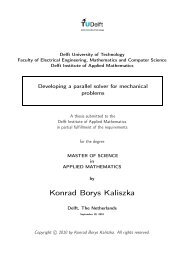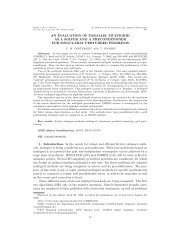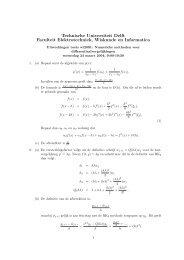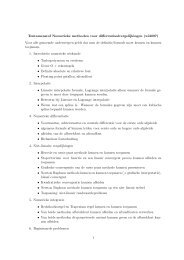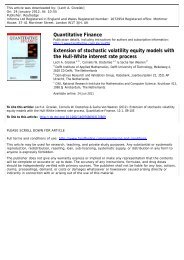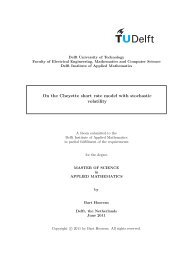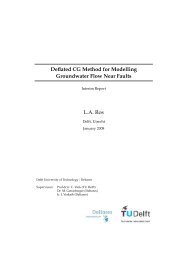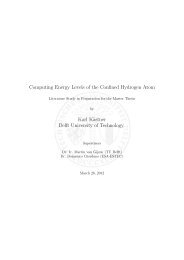Hydroelastic behavior of a floating ring-shaped plate
Hydroelastic behavior of a floating ring-shaped plate
Hydroelastic behavior of a floating ring-shaped plate
Create successful ePaper yourself
Turn your PDF publications into a flip-book with our unique Google optimized e-Paper software.
10 A.I. Andrianov & A.J. Hermanswhere we have introduced the function c (q)mn as a combination <strong>of</strong> Bessel and Hankelfunctions in the formc (q)mn = r 0[−r 1[kJ n+1 (kr 1 )H (q)kJ n+1 (kr 0 )H (q)nn(κ mr 0 ) − κ m J n (kr 0 )H (q) ]n+1 (κ mr 0 )], q = 1, 2. (27)(κ mr 1 ) − κ m J n (kr 1 )H (q)n+1 (κ mr 1 )From Equation (26) we can derive 2(M −2)(N +1) relations for the determination<strong>of</strong> 2M(N +1) unknown amplitudes. The set <strong>of</strong> equations for both cases <strong>of</strong> water depthis completed by the free-edge conditions (6–7) when the deflection function is insertedthere. These conditions at the edges ρ = r 1 and ρ = r 0 give us 4(N + 1) equationsM∑m=1a (1)mn d(1) mn,ij + a(2) mn d(2) mn,ij = 0, (28)where n = 0, ..., N, i = 0, 1, j = 1, 2, and the functions d (q)[()d (q)mn,i1 = H (q)n (κ mr i ) −κ 2 (1 − ν)n(n − 1)m +r 2 imn,ij are[(d (q)mn,i2 = H (q)n (κ m r i ) − n κ 2 m + (1 − ν)n2 (1 − n)r i(+ H (q)n+1 (κ mr i ) κ 3 m +]+ H (q)n+1 (κ (1 − ν)mr i )κ m ,r i)r 3 i)](1 − ν)n2ri2 κ m , (29)where q = 1, 2 is the Hankel-function index and r i is either inner-<strong>ring</strong> contour r 1 orouter-<strong>ring</strong> contour r 0 .From now on we consider the IWD and FWD cases separately.6. Ring on water <strong>of</strong> infinite depthHere the analytic study is given for the case <strong>of</strong> infinite depth. In the IWD case we onlyconsider part <strong>of</strong> the solution, namely that related to the water dispersion relation.The analysis given in this section is a good basis from which to derive a solution forthe general and most complicated case <strong>of</strong> water <strong>of</strong> finite depth. To demonstrate themethod we wish to use for the FWD case, we consider the contribution <strong>of</strong> the polek = k 0 in the IWD case. Here we ignore the contribution <strong>of</strong> the integral along theimaginary axis after closing the contour in (20). This means that local disturbancesare disregarded.The deflection <strong>of</strong> the <strong>plate</strong>, the Green’s function and the function F (k) are representedby expressions (21), (20) and (18a), respectively. For deep-water wave numberk 0 equals K, so k 0 = ω 2 /g.Now we analyze the k-integral in IDE (26). The integrand has the poles k = ±κ m ,shown in Figure 3, and can be represented as a sum <strong>of</strong> four integrals∫∞k 00k(k − k 0 )(k 2 − κ 2 m)[]a (1)mn c(1) mn + a(2) mn c(2) mn J n (kρ) dk= a (1)mn (I 01 − I 11 ) + a (2)mn (I 02 − I 12 ) , (30)AndrianovHermans.tex; 15/03/2005; 17:37; p.10


